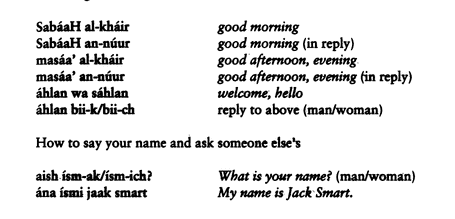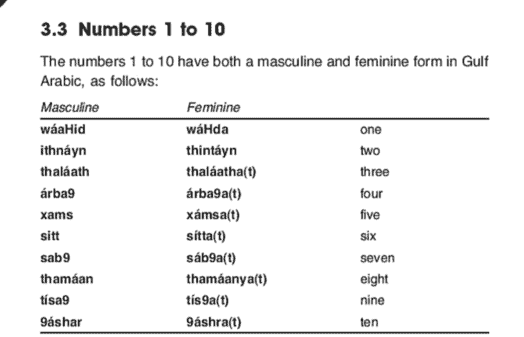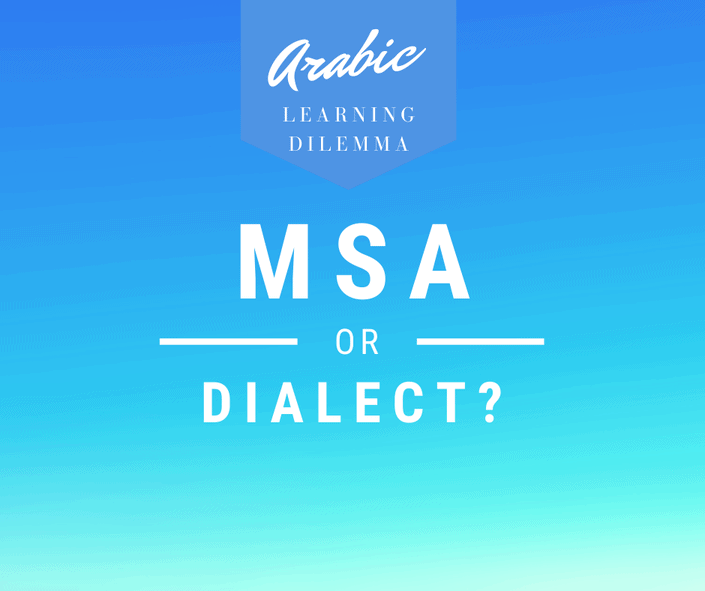If you currently live in one of the Gulf countries or planning to move there for work or other purpose, learning the local dialect will help you tremendously and it’s never too late to learn it.
You can learn Gulf Arabic online for free with the help of one or two self-study books.
Although many will tell you English will be enough to get by, learning Gulf Arabic will make for a much better quality of personal and professional life.
The colloquial Gulf Arabic, or Khaliji, as Arabs call it, refers to the dialect spoken in Saudi Arabia (KSA), Qatar, Bahrain, the United Arab Emirates (UAE), Kuwait and Oman.
The Gulf dialect varies slightly by the country where it’s spoken but people from the Gulf Cooperation Council (GCC) countries communicate with each other with ease using their respective variants of the dialect. In other words, don’t worry too much whether Saudi dialect is different from Emirati or Bahraini, for instance.
Although Yemen is located in the Arabian Peninsula , the dialect there is referred to as Yemeni and is not considered a Gulf dialect.
Now , if you are wondering where you can learn colloquial Gulf Arabic on your own, you definitely can and you will of course get better at it with time and practice.
I’ll share with you in this post the incremental steps that will make for an easy learning track.
In the first step, I’ll show you what you need to learn the Arabic alphabets and phonetics and the various combinations to make words. Surprisingly it is a lot easier to learn the 28 Arabic letters and vowels than what people expect.
The main objective from step one is for you to learn how to read at a basic level.
The second step will be to use one of the recommended self-study books below. You will learn conversational Gulf Arabic for day-to-day use. As you will see below, the books contain Arabic script, transliteration and translation of all the dialogues in addition to other pertinent information to living in the Gulf region.
The learning objective of the second step is to pick up Khaliji dialect survival skills to forgo English and interpreters.
The third step focuses on increasing your exposure to the Gulf dialect. I’ll share with you a list of YouTube channels in Gulf Arabic dialect with English subtitles. These channels offer free entertainment and social content that will help you improve your listening skills, increase your vocabulary and obtain the necessary exposure to the dialect.
If you currently live in the Gulf, you can complement that with listening to a local radio that airs in the colloquial Gulf Arabic particularly one that offers talk shows and local music for maximum exposure.

Table of Contents
Step 1: Learn the Arabic sounds and letters
Learning the Arabic script is essential to learning either Modern Standard Arabic or the Gulf dialect.
Although the Arabic script may look intimidating to non-speakers of Arabic, it is a pretty straightforward script consisting of 28 letters that includes six vowels.
The good news is this wouldn’t take longer than three weeks to master the alphabets and the various combinations of consonants and vowels. Generally, one week of regular study would be more than enough.
I recommend using the introductory book of choice for learners of Arabic. Alif Baa:Introduction to Arabic Letters and Sounds . It has been used for years in American colleges for the absolute beginners of Arabic.
If you are looking for a free alternative to learn the Arabic letters and sounds, please refer to this short list of the best YouTube channels for learning Arabic and pick any of the Arabic learning channels I recommend there.
Step 2: Learn conversational skills of Gulf dialect
Now that you know where to go to learn the basics, the expectation is you will be able to recognize and read Arabic letters and a few words, including road signs, store names and restaurant menus.
Your next challenge is to learn the basic conversational skills of the Gulf dialect. You will learn the survival and communication skills that will allow you to carry on your daily life even without resorting to English.
At this level, the learning objective is for you to learn how to exchange greetings, order food, ask for directions, speak with the doctor and maintain social interactions.
The colloquial Gulf Arabic, like all other Arabic dialects, is mainly an oral medium of communication whereas Modern Standard Arabic (MSA) is suitable for formal communication, newscasts, and government documents.
You are therefore expected to improve your listening and speaking skills to be able to interact in the Gulf dialect.
A very basic Arabic reading level to be able to read Arabic names and signs and short sentences is all you’ll need.
There are only two reputable and widely-used self-study books in print that I know learners use to study Gulf Arabic.
You can use either one of the following books to study the Gulf dialect. You can also use both if you choose to as long as you don’t use them simultaneously.
Although there are others publications, these are the only two I can recommend as self-study books for the Gulf Arabic dialect .
They have been used by many Western adult learners who were moving to the Gulf area to work in the health, oil and infrastructure sectors.
Frances Altorfer’s Complete Spoken Arabic of the Gulf is suitable for beginner to Intermediate learners of colloquial Gulf Arabic. Here are a few of my highlights of impressions I have about Altorfer’s Complete Spoken Arabic of the Gulf:
The presentation in this book is excellent.
Each unit has three dialogues. For each dialogue, you can listen while you follow either the Arabic transcript, the English transliteration or translation.
The dialogues translations are found at the end of the book and are extremely helpful since you won’t be scratching your head with nowhere to look for help if you are stuck.

Arabic words are transliterated phonetically following the correct Arabic pronunciation.
The book covers grammatical topics but does not go in-depth , which is perfect for the beginners using this book to learn about the spoken colloquial Gulf Arabic. However, this may eventually boil down to personal preference among learners.
The book uses a variety of photos, drawings and diagrams to depict pertinent places, currencies, landmarks, local items and other everyday use matters. It breaks monotony and brings the book to life.
The tone of the voice actors in this book are a little flat and neutral, and the overall content is simplistic and dumbed-down, which may be a deliberate choice so as not overwhelm the learners with what could be unnecessary cultural information at the beginner level.
In terms of language skills that could be gained from this book/audios, they can generally be categorized as survival skills that could amount to B2 level .
As for Clive Holes’s Colloquial Gulf Arabic– The Complete Course for Beginners, it is another good choice either as an alternative or in combination with the Complete Spoken Arabic of the Gulf book.
It contains 20 units in addition to the Answer-key and the fully translated dialogue transcripts. There are plenty of exercises that cover all the topics taught in the book.
This book, too, has the full translation of the dialogues at the end of the book as reference for the students.
There is a significant presence of grammar lessons throughout this book and plenty of exercises. This could be too much for some learners at this level, while others may enjoy it.
This introductory-to-intermediate Gulf Arabic book adopts a cultural approach in teaching, offering plenty of cultural context and information for learners, which can appeal to students who have a deeper interest in the local culture.
The content is quite varied, and the dialogues cover social issues, debates and even funny anecdotes and jokes.
The voice actors perform the dialogues with intonation, emotion, humor and even idiomatic expressions. They are far more fun and captivating than many Arabic teaching voice actors.
The book also contains a sizeable English-Gulf Arabic glossary that can help learners find equivalent terminology in Gulf Arabic to formulate their sentences.
The audio content is also downloadable/playable on the publisher’s website.
Although the grammar is well explained in this book, it could be overwhelming, and even frustrating to many learners, particularly for a spoken dialect. The grammar lessons, however, will definitely come in handy at a more advanced level or if you decide to learn MSA at some point.

The high-level and cultural content could be a distraction to some learners who are only interested in conversational Gulf Arabic to learn enough functional phrases. With that said, cultural enthusiasts will enjoy the contextual information.
With that said, learners can skip the minute grammatical and cultural concepts if they want to. It will not impede the progress of their learning.
There are very few significant differences between the two books, except for the focus on the grammar and general tone . The Complete Spoken Arabic of the Gulf is relatively more simplified and basic than the Colloquial Gulf Arabic, which contains a little more cultural and grammatical concepts than a beginner would care for.
Tip: You can start with The Complete Spoken Arabic of the Gulf first for its low entry, then jump to the Colloquial Gulf Arabic. They sort of complement each other despite the expected overlap. Since The Colloquial Gulf Arabic has more grammar and touches on the intermediate level towards the end of the book, it will be suitable to take you to the next level of your language learning.
Step 3: Increase your exposure to Gulf dialect
You don’t have to wait until you finish your self-study book(s) to start listening and watching Gulf dialect shows. You can start after a few weeks into your study path.
You will definitely not understand everything and probably not even half of what you hear, but you will be training your ears and brain on identifying the sounds and associating them with meanings .
As you continue to study the dialect, you will be able to understand more words and guess the meaning of expressions you never heard before.
Below are some free audio resources that offer authentic Gulf Arabic content for your learning and enjoyment. They also serve as a great window to the local Arab culture.
- Jana In Arabic is Youtube channel with English subtitles ran by a London-based Saudi female vlogger. She is from Jeddah, KSA and speaks with a slight Hijazi accent.
- Sawt Afkari , which roughly translates to The Voice of My Thoughts, is a Kuwaiti Channel ran by and for women. It airs talk shows, interviews and debates on women issues with English subtitles.
- Thamanyah is a Saudi channel that broadcasts documentaries, interviews, and comedy shows all with English subtitles.
- Belmokhba is a Kuwaiti Youtube channel with an extensive list of talk shows, interviews, comedy series and more. Although this is a Kuwaiti channel, most guests come from Saudi Arabia and the UAE. The spoken dialects range between Kuwaiti, Emirati and Saudi. Most episodes have English subtitles.
Step 4: Practice speaking Gulf Arabic.
This is probably the most fun and rewarding part of the whole learning journey as you get to practice what you have learned, make mistakes and improve your colloquial Gulf Arabic skills; but the most important part is that you’ll communicate in Gulf Arabic.
It’s not an easy feat, and you should congratulate yourself for even trying to learn this dialect.
The best method to practice and improve your Gulf speaking skills is to look for a Gulf dialect tutor nearby. If it’s not feasible, use an affordable online language platform like iTalki or Wyzant where you can pick a native tutor of your choice and practice your Gulf dialect with him or her.
My tip is to maximize your conversational time during your session with the tutor and seek correction on your pronunciation. For everything regarding your Arabic learning, you can learn it on your own.







